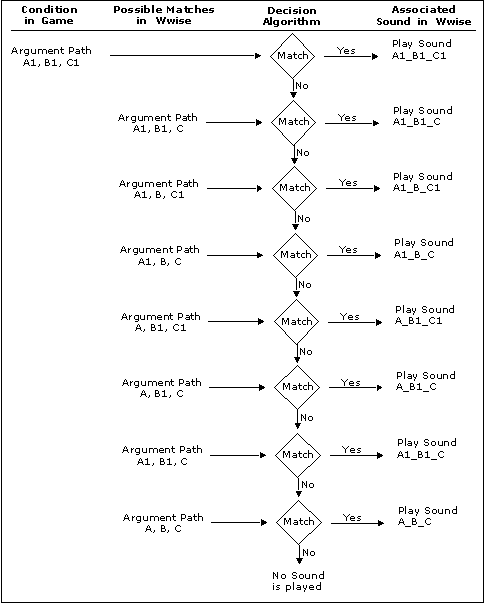After the Dialogue Event is populated with State Group and States, you need to define the rules by recreating each condition and outcome that exists in your game. This is performed by combining the different State Groups and States into paths.
Since it may be difficult to cover every situation or outcome, you will most likely want
to create fallback or default paths that can be used every time the sound engine encounters
a situation where a specific path has not been defined. These fallback paths use State
Groups instead of states.
Since it can be difficult, time-consuming, and very expensive to re-create every condition and outcome that exists in a game, you will want some kind of fallback mechanism to cover those situations you didn't think of or didn't have time to create. In Wwise, this is done by creating fallback paths. These fallback paths contain one or more State Groups instead of states and are generally associated with more general pieces of dialogue. For example, in an RTS game, you might have situations where the outcome of a certain operation is uncertain, such as the final destination of your army. To cover this situation, you can create a path where at least one State Group is used in place of a State. This path would then be assigned to a sound object that leaves the operation open-ended. In the case of your army on the way to its final destination, the sound object might be “Your army is advancing”.
Before creating the dialogue for a game, it is important that the scriptwriter understand how the fallback algorithm works in Wwise. Let's say you have a Dialogue Event with the following State Groups and States:
When the Dialogue Event is called by the game, the algorithm will try to match the current condition in game, let's say (A1, B1, C1), with one of the paths in the Dialogue Event to determine which sound to play. When more than one path matches the current condition in game, the mode of the Dialogue Event will ultimately decide how Wwise picks a path and corresponding sound. When a Dialogue Event is in 'Best Match' mode, Wwise will look for an exact match by verifying the current condition in game against the paths created in the Dialogue Event. If no exact match is found or if the matching path doesn't have an associated piece of dialogue, the algorithm will look for the closest match among the fallback paths, if any.
When a Dialogue Event is in 'Weighted' mode, Wwise looks for all matches including all fallback paths. From this list of matches,
it looks at the weighting of each path and from there determines which path to select and which piece of dialogue to play.
The following illustration shows how the 'best match' decision algorithm verifies all possible matches to determine which object to play.
Notice how the decision algorithm looks for fallbacks from right to left. In our example, it starts with C, then looks at B, and ends at A. The left-most fallback will only be considered when all other possible combinations are exhausted.
![[Note]](/images/2023.1.3_8471/?source=Help&id=note.png) | Note |
|---|
You can also create a generic path for a Dialogue Event.
The generic path covers all situations and ensures that a piece of dialogue will be played no matter which States are triggered by the game.
|
To create a fallback path:
Load a Dialogue Event into the Dialogue Event Editor.
Click a State Group or State for each of the State Groups in your Dialogue Event.
The Add Path button becomes active.
![[Note]](/images/2023.1.3_8471/?source=Help&id=note.png) | Note |
|---|
At least one State Group needs to be selected in your path to create a fallback path. |
Click Add Path to create a path.
The path is added the path list.
![[Note]](/images/2023.1.3_8471/?source=Help&id=note.png) | Note |
|---|
When a State Group is used to create a fallback path, the State Group is represented by an asterisk(*) in the path name. |
Continue to add new paths by selecting a different combination of State Groups and States.
![[Note]](/images/2023.1.3_8471/?source=Help&id=note.png) | Note |
|---|
To remove a path, select the series of states or the path itself and click Remove Path. |
![[Tip]](/images/2023.1.3_8471/?source=Help&id=tip.png)
![[Note]](/images/2023.1.3_8471/?source=Help&id=note.png)

